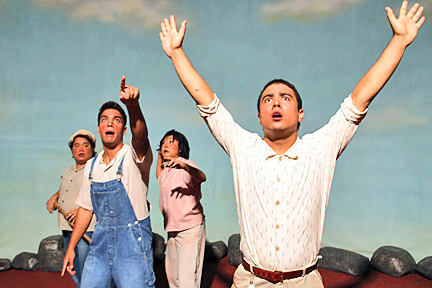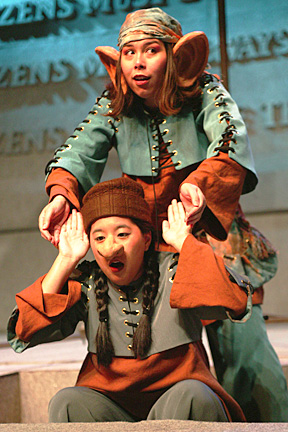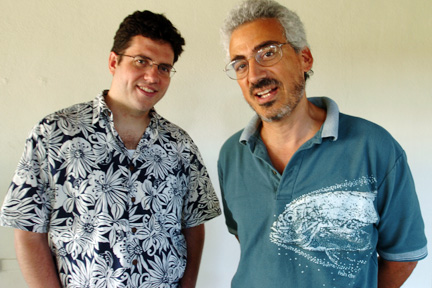
"Nothing Is the Same," a play about Dec. 7, 1941, featured BullDog, left, Reb Beau Allen, Janice Terukina and Jason Kanda.
Dream-weaver taught
youth theater to wing it
BIG moments -- accepting a diploma, crossing the finish line first, taking a bow to cheers and applause -- stand out as the most memorable of life's events. Yet for all the grandeur of these accomplishments, it is their back stories that fuel our memories. The sweat of late nights studying, of hours training and rehearsing, intensify our experiences to cement them in our minds.
Mark Lutwak can write a book about accomplishment. As artistic director of Honolulu Theatre for Youth since 1999, he has overseen some 45 productions and directed about 25 of them. Under Lutwak's direction, HTY plays have won several prestigious national awards and have been included in prominent national festivals. This year's "Nothing Is the Same," a tale about Dec. 7, 1941, as seen through the eyes of youngsters growing up in Wahiawa, has played at Kennedy Center in Washington, D.C., as part of the "New Visions, New Voices" festival. The production of "Dis/Troy" (2003-2004) did the same. "Pidg Latin" (2000-2001) won the AT&T Onstage Award, which honors the playwright with a cash award and provides major funding for production of the play.
Prior to Lutwak taking the reins, HTY had already received funding from the National Endowment for the Arts. Nationally the full-time theater company has long been respected as a top arts institution. But the successes have not come easy. In a cultural and political climate that has continued to turn attention and funding away from the arts, Lutwak has struggled to keep the theater flourishing. As is typical for a nonprofit director, his biggest challenges have been about money.
"Our budget is not much more than it was 10 years ago, so the services are coming off the backs of those who work at the theater," Lutwak says. HTY staff hasn't had a raise in some five years.
The lack of financial resources extends to every facet of the operation. Set design, for instance, has suffered big hits.
"While the budget hasn't grown in 10 years, steel prices have doubled," Lutwak says. "We're essentially building stuff with -- for lack of a better word -- garbage. You can't cover up for not having the proper materials.
"We're working in a climate where everything is pushed to the limit." Lutwak himself has worked 80 to 90 hours a week as artistic director.
"When you're outside an arts organization looking in, the life of an artistic director looks great. You've got a steady job, you've got health insurance. You get to pick the plays and direct what you want."
But Lutwak also handled marketing, personnel and advertising chores, managed the HTY Web site and ran errands. "The position is an art in itself," he says.
Thus, after six years of eating, sleeping and breathing HTY, Lutwak is handing the reins to Eric Johnson, who is "much younger, has fresh ideas and lots of energy, and a lot fewer scars." Lutwak will be on hand to assist Johnson with the transition into the 2005-06 season and will continue to oversee a few HTY productions.

Nara Springer Cardenas and Monica Cho Coldwell star in "The Last Paving Stone." Both it and "Nothing Is the Same" were written by Y York, wife of Mark Lutwak, former artistic director of Honolulu Theatre for Youth.
HTY worked with local author Nora Okja Keller on the Korean folk tale "When Tiger Smoked His Pipe," Gary Pak on "Beyond the Falls" and journalist Lee Cataluna in an adaptation of "The Musubi Man," to name a few writers.
Each year for "Xmas Talk Story," Lutwak works with new and established writers whose short stories tell about local children's experiences of the holiday season.
"It's about strengthening what's here, not bringing stories from somewhere else," Lutwak says. "Hawaii is distinctly its own culture and community. Stories should express the reality children here are growing up with. We don't need to do another 'Sleeping Beauty' again. You can get that any day of the week. It's about enriching our own culture."
Part of the culture Lutwak has embraced in play-writing is pidgin. He says HTY frequently receives letters from teachers, but the biggest issue in schools is pidgin.
"There is always a significant minority that is against it. They say pidgin is holding children back and reinforces bad habits. Then there is the other strong minority who finds it liberating. They say their students hear the pidgin (on stage) and can suddenly write."
Lutwak fell in love with pidgin the instant he heard it. It was at a reading of "Eddie Would Go," years before he joined HTY.
"I was lifting off my seat; it was so exciting! Coming from the outside, Creole language is the most exciting stuff. It draws on culture and is gorgeous to the ear. You can score pidgin to music because it's inflective.
"I'm not into pidgin for its own sake, but if the best work of writing is in pidgin, I'll use it."
And use it HTY does, with intelligence and flair, understanding that pidgin transforms through time and from place to place.
Pidgin is used in "Nothing Is the Same," set in Wahiawa during World War II. "For kids in Wahiawa in 1941, that was the language they spoke," Lutwak says.
For "Beyond the Falls," about koi in a Hawaii fish pond, writers created a fish pidgin. "Pidg Latin" told the story about a youth who attends a Latin class at the University of Hawaii and translates Latin into pidgin. "That's how we talked about the issue without using it," says Lutwak.
The annual "Xmas Talk Story" is filled with tales told in pidgin. "It's interesting because most writers of pidgin are teachers," he says.

Mark Lutwak, right, is handing over the reins at Honolulu Theatre for Youth to new artistic director Eric Johnson.
Lutwak became HTY's artistic director after freelance-directing several plays for them over a couple of seasons. When the company's artistic director suddenly had to leave the post in 1999, Lutwak says he asked friends to apply so that he could keep getting work. After a while, he realized that his extensive freelancing had provided him the skills to apply for the position himself.
"There are two reasons we took it," Lutwak says of himself and York. "One: the pool of actors here. It's so exciting to work with this company: BullDog, Cynthia See, Junior Tesoro, to name a few. We can put a play together so fast, we're almost telepathic. New folks get pulled up fast working with this group. It's the best training for a new actor. They're just marvelous.
"Two: the other artists we get to work with." He names lists of set designers, musicians and costume designers whom he says raise the level of works produced.
"An artistic director can come up with ideas, but the great part is collaborating with other artists. So the most incredible attraction, the most rewarding part, is fresh, exciting talent."
AS FOR WHAT'S next, Lutwak's first answer is "I don't know." He seems to find freedom in the unscripted life. Then he admits he's looking into a science education project, directing several shows a year on the mainland and continuing to work with HTY on "Nothing Is the Same" and "Xmas Talk Story."
One thing he does seem definite about: staying in Hawaii.
"I've grown up all over the country, and this place feels more like home to me than anywhere else. In many places in America, you're either 'right' or 'the other,' because everyone's the same.
"There are so many cultures here, so concentrated, kids can culturally surf," he marvels. "Most actors here are Creole, always looking out of two or more cultures. To me it's a modern human being who can step in and out of cultures and embrace them all.
"New York is another place with a concentration of cultures. New York and Hawaii are two models of how the future can be. I'd much prefer Hawaii."
E-mail to Features Desk
[News] [Business] [Features] [Sports] [Editorial] [Do It Electric!]
[Classified Ads] [Search] [Subscribe] [Info] [Letter to Editor]
[Feedback]
